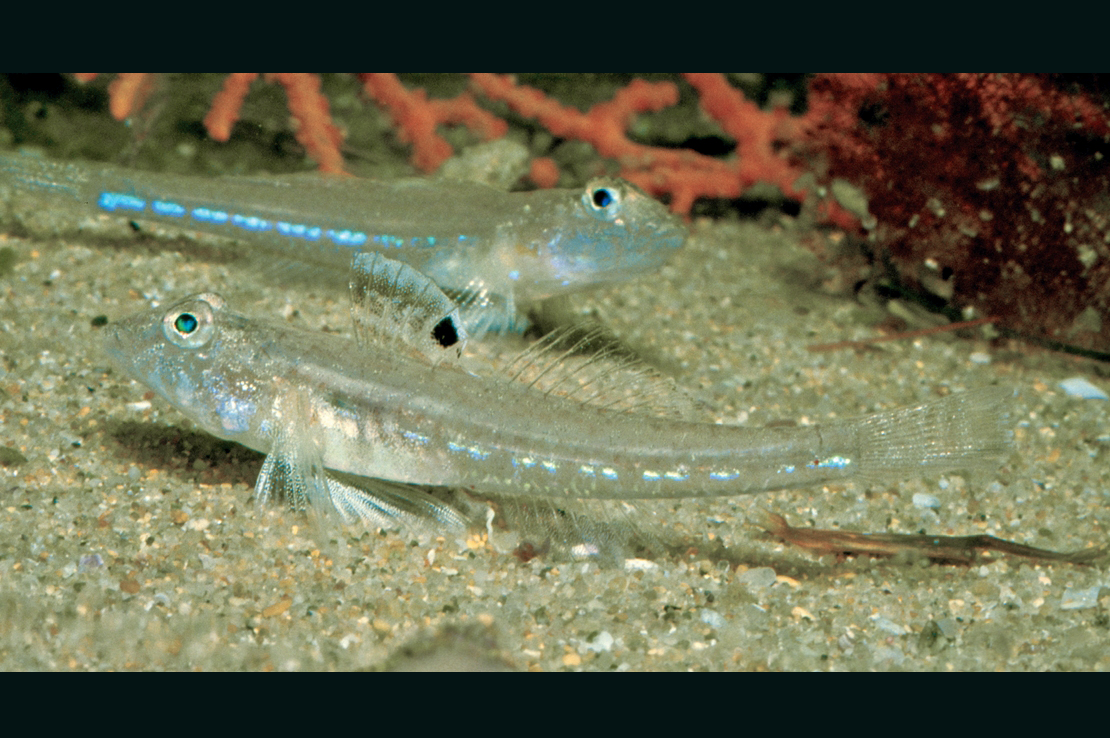- Classification
- ACTINOPTERYGII
- PERCIFORMES
- GOBIIDAE
- Nesogobius
- sp. 1 (of Hoese & Larson)
Opalescent Sandgoby, Nesogobius sp. 1 (of Hoese & Larson)
Other Names: Pale Sandgoby

Opalescent Sandgobies, Nesogobius sp. 1 - female (with black spot on dorsal fin) in front, male behind. Source: Rudie H. Kuiter / Aquatic Photographics. License: All rights reserved
Summary:
A pale translucent sandgoby with a broken silvery stripe just below the midside, scattered small yellow blotches, small orange or brown widely-spaced spots along on the midside, an orange or brown bar from the front of each eye to the middle of the jaws, a small triangular brown spot on the middle of the caudal peduncle, and sometimes thin wavy vertical grey bands on the tail. The first dorsal fin is yellowish with scattered small black spots and a large black spot near the rear of the first dorsal fin in females, while males have a clear first dorsal fin.
Cite this page as:
Bray, D.J. 2020, Nesogobius sp. 1 (of Hoese & Larson) in Fishes of Australia, accessed 27 Jun 2025, https://fishesofaustralia.net.au/Home/species/5287
Opalescent Sandgoby, Nesogobius sp. 1 (of Hoese & Larson)
More Info
|
Distribution |
Known only from Port Phillip, Victoria. Inhabits sparse seagrass beds and adjacent sandy areas at depths of 3–10 m. |
|
Features |
Dorsal fin VII + I, 9-10; Anal fin I, 8-10 Caudal fin (segmented rays) 13 (9 branched); Pectoral fin 16-18; Pelvic fin I, 5. Gill rakers 1-2 + 6-8 = 7-10. Body slender. Head of moderate size (26-29% SL), broader than deep; interorbital narrow, eyes almost touching; mouth oblique, small, rear end of jaws below front quarter of eyes; pore by each nostril (rarely with two or three median pores between eyes) and pore behind middle of each eye; pore above rear of each preopercle, no preopercular pores; gill openings broad, reaching forward to below middle of opercula; no groove behind posterior margin of each preopercle; tongue tip truncate. Head without scales; body scales ctenoid, in 23-28 vertical rows, scales extending forward to a line between middle of pectoral fin insertions and rear end of first dorsal fin; midline of belly without scales; pectoral fin bases without scales; area before pelvic fins without scales. Two dorsal fins, first dorsal short, with triangular to rounded margin, originating above ventral fin insertions; second dorsal origin just behind first dorsal fin; anal fin origin below and just behind second dorsal origin; caudal fin short, with truncate margin. Pectoral fins large, reaching to anal origin, margins rounded. Pelvic fins fused to form large cup-shaped disc, originating just below and behind pectoral fin insertions, reaching to anal fin origin. |
|
Colour |
Translucent, with scattered small yellow blotches; orange or brown bar from front of eye to middle of jaws; midside often with widely spaced, small orange or brown spots; silver or white broken longitudinal stripe just below midside; rear of caudal peduncle with small triangular brown spot midlaterally; fins mostly clear with few small scattered white spots; first dorsal fin yellowish with scattered small black spots and enlarged black spot near end of fin in females; caudal fin sometimes with thin wavy vertical grey bands. Males with clear first dorsal fin. |
|
Remarks |
The Opalescent Sandgoby was treated as Nesogobius sp. 6 in Gomon et al. (1994). |
|
Similar Species |
The Opalescent Sandgoby is easily confused with Nesogobius sp. 5, as both have a black spot on the first dorsal fin. Nesogobius sp. 5 has the spot only in males, while Nesogobius sp. 1 has the spot only in females. Both species are small and and well-camouflaged. |
|
Author |
Bray, D.J. 2020 |
Opalescent Sandgoby, Nesogobius sp. 1 (of Hoese & Larson)
References
Hoese, D.F. & Larson, H.K. 1994. Family Gobiidae. pp. 781-810, in Gomon, M.F., Glover, C.J.M. & Kuiter, R.H (eds). The Fishes of Australia's South Coast. Adelaide : State Printer 992 pp. 810 figs. (as Nesogobius sp. 6)
Hoese, D.F. & Larson, H.K. 2008. Family Gobiidae. pp. 749-773, in Gomon. M.F., Bray, D.J. & Kuiter, R.H (eds). Fishes of Australia's Southern Coast. Sydney : Reed New Holland 928 pp.
-
Fish Classification
-
Class
ACTINOPTERYGII Ray-finned fishes -
Order
PERCIFORMES Perches and allies -
Family
GOBIIDAE Gobies -
Genus
Nesogobius -
Species
sp. 1 (of Hoese & Larson)




